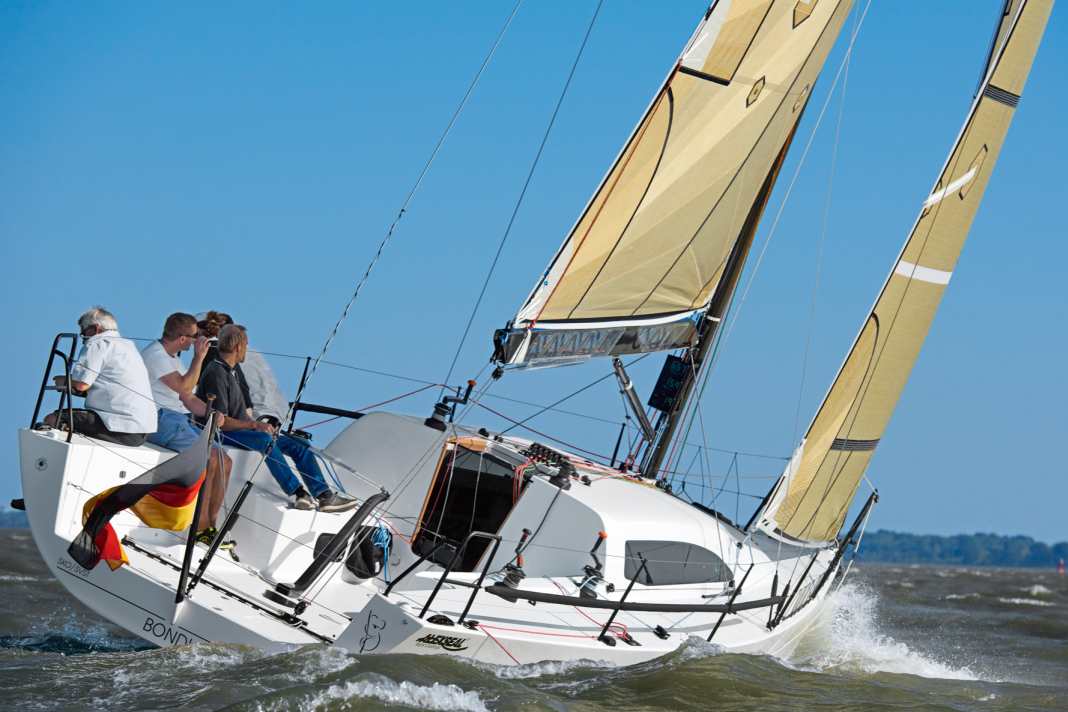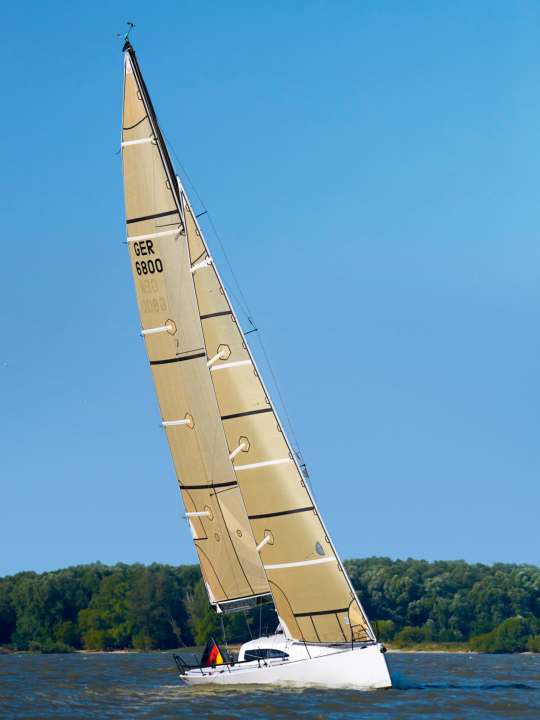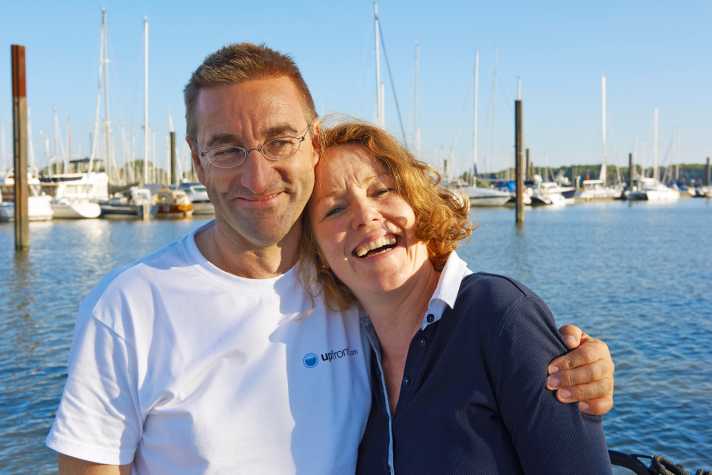Silverrudder winner: Carbon fibre self-build "Bondi" rocks the cult regatta






- First impressions on board "Bondi"
- Barrage of highlights from the world of composites
- Perfectionism seems almost scary
- Downwind, "Bondi" redefines trouser seat sailing
- "Never really fallen flat on my face"
- Tinkering with the family racer to balance out everyday working life
- "We're building a little dream here"
- Technical data of the "Bondi"
- The owners
After 23 hours, 9 minutes and 24 seconds, Sven Kurka had done it. In the "Keelboats Large" category with boats between 35.01 and 40 feet, no one could sail faster single-handed around Funen in the Silverrudder 2024. What makes this boat such a winner? Our colleague Matthias Beilken was already on board "Bondi" in 2017. With this boat, Kurka built his dream of the perfect cruising boat himself. The modern, fast crack is less special than the skilful implementation and attention to detail.
First impressions on board "Bondi"
A toothbrush is lying in the cockpit locker on the port side, tangled up and obviously often used. Here, people like to clean extensively, even in the corners. All surfaces of the high-tech yacht "Bondi", which is only a few weeks old, look almost pedantically perfect - a condition that the owner endeavours to maintain. The sheer carbon-fibre rig with its conspicuously cinched boomerang spreaders and discreet self-spliced Dyneema lashings sits enthroned above a hull that looks very much like a Mumm 36 fresh out of the egg. And the path of the white and very reduced deck layout, which corresponds to that of a modern racer of the very highest quality, is only rarely interrupted by a high-tech detail: here a loop that is neatly spliced to a sheer Dyneema core and disappears below deck as a gennaker barber hauler, there an abrasion protection plate made of carbon fibre.
One thing is clear: a paint-and-loop fetishist with a penchant for sailing perfection was raging on deck. His name is Sven Kurka. The young man from Stade on the Elbe was a hardcore and regatta sailor, especially on dinghies. In the 470 and 505, he was probably one of the best foresailors in the country, and he was youth champion in the Pirat. His technical understanding and perfectionism have always been notorious. "But I no longer want to race around the buoys like a wild man," he said. And that's why there is "Bondi", the name of his self-built boat.
Also interesting:
The plug-in bulkheads almost fly out of your hand, they are so light. Naturally, Kurka has laminated sandwich panels with the smoothest visible carbon fibre. And so that they don't scratch, but slide better, he has lined the guide surfaces on the sides with Teflon. Below, the feet step onto something that would probably pass for polished Carrara marble if it weren't black and carbon fibre. Under the rungs to the companionway - also made of carbon fibre, of course - a rotary valve for an extendable riser pipe discreetly reveals that there are no lockers or cupboards aft of the berths, as the tanks for the water ballast are located there.
Barrage of highlights from the world of composites
Down here, "Bondi" doesn't look like an uncompromising racer. If only because of the cosy saloon berths with their green upholstery and the impeccably planned wet room. However, it is brimming with silent witnesses to the art of engineering and design. A bear proves that bearded, iron-bending and wood-rattling boat builders in fishermen's shirts played no part at all in the creation of "Bondi".
It is called "Bondi-Koala" because the yacht's lines are of Australian origin, even though they actually come from Stade. Kurka's friend Karsten Jarke, the creator of "Bondi's" lines, now lives in Sydney, with the koalas. And such a plush fellow now watches over the contents of the card table - the flap of which was of course also laminated in visible carbon fibre. The "Bondi-Koala" mascot also wears a bow tie made of carbon fibre.
The animal ("Bondi" is pronounced "Bondei", by the way) is guarding a treasure. These are pictures of building, laminating and everything. They don't show a scurrying workbench, rather a building laboratory, a group of friends, but Kurka right in the middle of it all. Pictures of planking the first foam strips, of wrapping the block in vacuum film, of positioning the epoxy resin pots for infusion ...
Such a barrage of highlights from the world of composites on and below deck may stir up a longing for wood in some viewers - after all, this is a boat. The eye glides favourably over the matt-oiled wooden surfaces of the cupboards in the saloon and galley. But when the hand strokes the wood in the same way, it turns out that the cupboards are also fine carbon fibre boxes, veneered with just a wafer-thin layer of wood! What a marvellous, because consistent sacrilege!
But there: under the port aft berth, isn't that a boiler? This is clearly not a racer, there must be a woman on board who has something to say. And her name is Andrea. Sven Kurka got her sailing on Lake Garda when he was travelling with helmsman Ulf Pleßmann from Stade. And since a morning trip in a 505, she has been keen to sail. The couple used to sail a Nissen monohull, the former "Chaca", which represented Germany at the 1998 Commodore's Cup in Cowes. Andrea Kurka: "She was like a member of the family to us." The sadness was correspondingly deep when she was finally sold.
Perfectionism seems almost scary
Sven and Andrea Kurka come on board, he makes it short: "I made everything you see here myself." He says this under the black boom cover, whose straight stitch seams would do credit to any professional seamstress in a sailmaker's workshop.
Kurka has always been a perfectionist. But this thing here is the bottom of the barrel; this perfectionism seems almost uncanny. No wonder that many high-tech freaks have followed the development of this ship with great interest. After all, it was obvious that it would set and define standards throughout Germany.
Also under sail, of course. The precisely curved carbon fibre tiller rocks back and forth slightly, we attach the telescopic boom. And use the many interesting details that confirm the exclusive status of this ship - such as the "17,000-volt winches", the small black ones from Andersen. "Have you ever seen them? They're the only ones in Germany." Similar to cars, they are statically paint-baked in special chambers heated by electricity. Andersen's winches are normally bare. An experiment that dealer Peter Kohlhoff from Kiel has carried out on "Bondi's" deck.
Kohlhoff in general - he has really let off steam here: the many loops and special fittings. He is also Kurka's friend, who knew that this yacht is also a bit of a showcase. Like others, obviously. Sailmaker Bernd Unglaub from Stade, for example, or sail designer Uwe Steingroß from the Segelform design centre (formerly the state-owned Olympic sailmaking company FES) in Rostock. Their one-off mainsail (classic without "fat head") goes into the rig on the 1:2 halyard.
Downwind, "Bondi" redefines trouser seat sailing
The crew is strong. It's like being on a racing yacht: jibes, angles, gusts, few words, lots of decisions. The ten-knot mark falls under gennaker. The builder on board: attentive, athletic, fast, a professional regatta sailor. Nominally, he trims the main and the gennaker on the beam. But he is actually everywhere at the same time, wagging back and forth. Because he knows every little thing better than any other living creature, no matter how small.
But there are no "small parts" on "Bondi". The 36-foot yacht sails at full speed and even corresponds in detail to the Grand Prix yachts currently on offer internationally. And that is above all clarity, reduction and function. Absence of fuss. No binding straps knotted to aluminium foot railing profiles with other pieces of fabric. No shackle-to-shackle chains, no railing nets. Much of the deck seems to have been freshly imported from the TP 52 or Fast 40+ classes and stems from the minimalist French style of outfitting. Among other things, it strives to replace metal with high-performance fibres.
The cockpit ergonomics are equally impressive. The hull is deep enough to suggest protection, but also spacious enough to form a fun working platform. The cockpit has no coaming and only half benches like many of today's cruisers/racers. In other words, short thwarts that end at about tiller root height, so that the mainsheet trimmer behind the seated helmsman is already leaning in the open space with the traveller control line at his feet.
Downwind, "Bondi" redefines trouser-bottom sailing because, trimmed to the point, she runs exactly on track when the bum is pushing. She then sails just below the seven mark, with wonderfully sharp cross angles. She can be steered in two ways: sitting directly from the tiller on the bench or high up on the side deck with the boom between your knees and your heels in the bank beads. She requires concentration, but is not a bitch.
"Never really fallen flat on my face"
"She's never really fallen flat on her face," says Kurka, probably a somewhat vivid description of controlled sailing characteristics. In any case, "Bondi" sails with pinpoint precision and feels safe - even when the sail pressure and heel increase and the seat of the trousers wants to slide gently over the deck.
The fact that "Bondi" has never "fallen flat on her face" may be due not only to the rudder but also to the well-fitting sails from Stade. There are several on board, as Kurka sewed them all himself in Bernd Unglaub's workshop. Unglaub only handled Steingroß' designs. Literally - from the roll to the plotter. He "nested" (arranged) the panels and specified the fabric together with Kurka and Steingroß. And that's quite something: for the headsails, they chose "Maxx", the asymmetric laminate from Contender, which enables the economical production of horizontally cut, slim high-tech sails thanks to its weft threads made of aramid ("Kevlar") arranged at bent angles. Applications in this size are exciting. The headsails do not overlap, the main remains classically radial.
Tack follows tack. Thanks to "Bondi's" clarity and manoeuvrability, the competent crew and the non-overlapping headsails, it is a pleasure to react to small gusts and turns. As hardly more than two fingers have to work on the wind, there is enough capacity to look at the America's Cup-style boom: a feast for the eyes! A filigree weave of carbon fibre tubes covered with transparent polyester film. And the aft end consists of nothing but a lever made of carbon fibre, the pin of which is bolted into the foot. Only a thin line leads forwards in the boom, no heavy tackle.
The only thing that is not immediately clear is the function of the two miniature ropes on the starboard side, one thick and one thin. Because they come out of just one thimble behind the bench without being jammed. The solution is found after a long line chase next to the forward berth: the lines remotely operate a stopper that works with tightening ropes and controls the bowsprit from Fiberwork in Berlin. A part called a constrictor pulls a rope sheath over the sprit outhaul and blocks it; the thin line cancels the blockage. The sprit is therefore stopped in the foredeck, where the load occurs.
Tinkering with the family racer to balance out everyday working life
After sailing, the bear and beer are waiting below deck. Where exactly does the former come from? Bondi Beach, Sydney. This is probably the most colourful beach in Australia's pearl city around the famous Sydney Harbour. "Bondei" is known far and wide as one of the most exposed surf spots, attracting a colourful mix of people. Karsten Jarke settled here after completing his studies and named his design studio after the famous beach. In the past - when Sven Kurka was one of the best 505 sailors in the country - Jarke designed centreboards and rudders for the planing dinghy thanks to close collaboration between Stade and Australia. Other small details were added. But "Bondi" is undoubtedly Jarke's masterpiece.
Kurka is extremely well connected, mainly due to his international dinghy sailing: he knows many experts, has access to all kinds of technologies and his name is a guarantee of professionalism. In real life, Kurka actually works in an office somewhere in the construction industry. There, the mechanical engineering graduate deals with technology, but not always with nice people. The tone is often rough and not necessarily complex, explains Kurka. In this respect, the complex tinkering and screwing on his family racer is a very welcome and suitable counterpart.
Speaking of mechanical engineering: "The keel fin is too sensitive an area not to take care of from the ground up," says the owner. For this reason, the design and manufacture of the delicate steel frame was created virtually on site in almost intimate collaboration with a friend who is also a mechanical engineer. Kurka modelled the shape of the bomb under the T-keel out of foam, then lead was cast. He explains the construction with which the ballast body is bolted under the fin. The word "blind hole" makes the uninitiated laugh (a blind hole is a kind of cylindrical countersunk hole).
The "blind holes" conjure up memories of the workshop in Hamburg-Schenefeld: "Nothing is unplanned here," said the Kurkas at the time. And although the hull and deck were still unfinished, the finished built-in parts were already underneath: Table and drawers, next to them panels made of monolithic carbon fibre, which were actually baked for Eurofighters but no longer met the standard. After a tensile test, Kurka used them as mast foot plates and forestay shrouds.
"We're building a little dream here"
"Bondi" became light. The displacement of the carbon racer is only 3,500 kilograms, with 2,000 kilograms being accounted for by the keel and bomb. That is a ballast ratio of an incredible 57 per cent, a figure that no conventional cruising boat can match. The low weight is the reward for precise work. For example, Kurka calculates that the filler on the hull, which is laminated over mallen, would only weigh 18 kilograms. He had swept up the sanding dust, weighed it and subtracted the value from the container weight ...
Nevertheless, it is not an extreme boat. The width of 3.57 metres with a length of 11.00 metres is still moderate, the draught of 2.29 metres is acceptable, the appendages are sporty and delicate, but have proven to be manageable from a sailing point of view.
And now? "Bondi" is lying on the jetty. Realised visions with a positive basic character should command respect from observers. Especially when the finished product belongs to the "cutting edge technology" category. This often results in very well thought-out projects and/or perfect eye-catchers that are bursting with expertise. This is different, because there are many unfinished low-tech projects or those that actually have more to do with therapy than with boatbuilding. But when someone consistently follows through with their vision against all odds, it is very impressive. And then there is usually speculation about the price.
In short, no one can quantify such projects and estimate the time it takes to familiarise themselves with new technologies. Kurka: "I once started counting hours, but quickly gave up." Four years ago, he said: "We're building a little dream here."
Kurka's "Dreamboat" project, the carbon fibre construction in a backyard workshop in Hamburg-Schenefeld, was well known and networked in Germany's small high-tech community. Such as the composite expert Manfred Schreiber and his related company Gurit, the carbon fibre tube winding specialists Michael Rehberg and Gunnar Bahr at Fiberwork in Berlin or boat builder Wolfram Heibeck from Hooksiel (Kurka: "Daniel Düsentrieb"), who built the Open 32 "Black Maggy" (now upgraded with a buoyancy plank according to the Dynamic Stability System) and superiorly won his class at the big single-handed race Silverrudder around Funen. Kurka's treasure thus enriches the small illustrious circle of modern northern European boat building.
A christening present, a photo, shows Kurka on a wooden plank across the open hull, floating, laminating. Loose T-shirt, paintbrush in hand: boat builder's uniform. Sven Kurka, a self-made fibre composite virtuoso (motto: "God grant that it sticks"), who can hold his own with the professionals on the scene. He confirms an old rule of life: "If you are faced with a difficult choice, choose the more radical option." Meaning: really go for it, tackle the "crazy" and leave nothing behind. Realise the vision.
Technical data of the "Bondi"

- Designer: Karsten Jarke
- Torso length: 11,00 m
- Width: 3,57 m
- Depth: 2,29 m
- Weight: 3,5 t
- Sail area on the wind: 78 m2
- Sail carrying capacity: 5,8
The owners

Before the "Bondi", Sven Kurka from Stade in Lower Saxony and his wife Andrea already had an ambitious boat for unusual fast voyages in the form of a Nissen one-off. The 53-year-old mechanical engineer has the qualifications from his profession to build a carbon cruiser that suits him perfectly as a former thoroughbred dinghy sailor.
The article first appeared in YACHT issue 17/2017 and has been revised for this online version.

